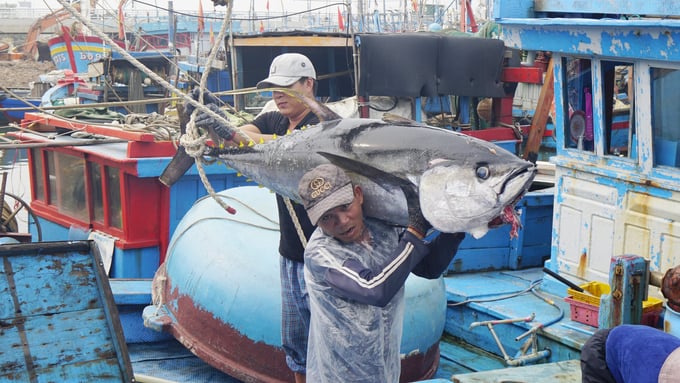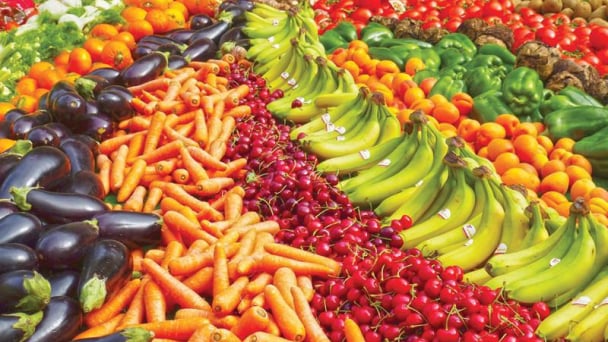May 21, 2025 | 05:32 GMT +7
May 21, 2025 | 05:32 GMT +7
Hotline: 0913.378.918
May 21, 2025 | 05:32 GMT +7
Hotline: 0913.378.918

Tuna is one of the three largest seafood exports in 2023, along with shrimp and pangasius.
VASEP said that in March 2024, Vietnam's tuna exports prospered, increasing by 17% and reaching nearly USD 84 million.
Notably, tuna exports have increased by 16% in the US market, reaching more than USD 32 million. Orders to the EU also increased by 30%, reaching USD 19 million. Tuna exports to Italy and Germany, the two largest import markets for Vietnamese tuna in this bloc, continue to grow well. Exports to Israel and Canada also accelerated in March, with 95% and 143% growth rates, respectively.
However, many markets in the EU, such as the Netherlands, Spain, and Lithuania... are reducing imports from Vietnam. Some other leading markets, such as Japan, decreased by 18%, Mexico decreased by 38%, Chile decreased by 34%, and Thailand decreased by 78%.
In the first three months of 2024, tuna reached a turnover of USD 215 million, up 19% over the same period in 2023 but 17% lower than in 2022. The highlight in the first quarter was the recovery of the Russian market, with capital showing signs of increasing again from the end of 2023.
In March 2024 alone, tuna exports to Russia increased by 4% compared to the same period in 2023. Accumulated in 3 months, exports to this market increased by 65%, reaching nearly USD 9 million. This figure made Russia the first quarter's fourth-largest single tuna export market.
By the end of March 2024, Vietnamese tuna had been exported to 86 markets worldwide. Of these, the main markets are the United States, the EU, the bloc of countries participating in the Comprehensive and Progressive Agreement for Trans-Pacific Partnership (CPTPP), Israel, Russia, the Philippines, South Korea, and Thailand, accounting for 90% of total exports.

Phu Yen, Binh Dinh and Khanh Hoa are the three localities with the largest tuna production in the country.
Mrs. Nguyen Ha, tuna market expert of VASEP, said that with this export speed and the difficulties the tuna industry faces, it is forecast that tuna exports in 2024 may exceed the turnover in 2023 (USD 845 million). Still, it is challenging to re-establish the record of USD 1 billion like in 2022.
According to VASEP, about 40 - 50% of Vietnam's tuna export market share is directed to the US market, and the remaining is scattered in two regions, the EU and ASEAN. Some other countries, such as Canada, Japan, Saudi Arabia, etc., also love Vietnamese tuna.
To exploit fisheries sustainably, the Ministry of Agriculture and Rural Development (MARD) has proposed a strategy for the fisheries industry to increase aquaculture and reduce exploitation output. Therefore, marine exploitation output in the first three months of 2024 is estimated to reach 833.6 thousand tons, down slightly by 0.1% compared to the same period in 2023.
For tuna, fishing output in the first three months of 2024 in 3 key fishing provinces is estimated at 5,392 tons, down slightly by 0.8% over the same period last year. Of these, only Binh Dinh saw exploitation growth, reaching 3,916 tons, an increase of more than 4% over the same period in 2023. On the contrary, the remaining two localities both decreased by about 12%.
Many experts predict that tuna products will regain growth in the world market. However, Vietnam's tuna industry is still facing many challenges, limiting its growth momentum in the last nine months of the year.
Specifically, the price of raw tuna in Bangkok has dropped to its lowest level in the past three years. Tensions in the Red Sea continue to rise. In the first quarter, this had little effect on exports. Still, Mrs. Nguyen Ha believes that, with the current increase in shipping costs and longer-than-expected delivery times, businesses will need more time to rotate capital and ensure production cycle.

VASEP is concerned that the IUU yellow card warning will affect tuna exports.
VASEP is also concerned about some export procedures. Among them, the problem of issuing Statements of catch for raw material (SC) at fishing ports is constantly being delayed. Some businesses reported that they could not get an SC certificate because the fishing port management board said the fish were large and not yellowfin tuna (the subject of exploitation).
In addition, businesses also complain about the difficulty of obtaining a Health Certificate (HC) for shipments containing raw materials from long-term ships. The reason is the management agency's assessment that product quality is difficult to ensure if the boat does not transship for long, from exploitation to loading and unloading when docked.
Regulations on not mixing aquatic raw materials originating from imported exploitation with aquatic raw materials originating from domestic exploitation into the same export batch, according to Decree 37/2024/ND-CP, also confuses businesses.
Ocean tuna is an essential target of Vietnam's offshore fisheries. Due to the characteristics of exploited species, including yellowfin tuna, bigeye tuna, and skipjack tuna, they often live offshore and have long-distance migratory habits to move from one country's waters to another, depending on the development stage.
The Department of Fisheries said that many countries can exploit a school of tuna. Therefore, tuna resources can only be well managed if there is sharing and cooperation between nations, mainly currently, based on the legal framework of the 1995 United Nations Fish Stocks Agreement.
In the Law On Fisheries 2017 and Decree No. 26/2019/ND-CP dated March 8, 2019, the Government stipulates that the maximum fishing output depends on the resources of each sea area. With tuna, the MARD focuses on ten coastal provinces and cities: Da Nang, Quang Nam, Quang Ngai, Binh Dinh, Phu Yen, Khanh Hoa, Ninh Thuan, Binh Thuan, Ba Ria-Vung Tau and Tien Giang.
On April 11, Deputy Minister of MARD Phung Duc Tien signed and issued Decision 1037/QD-BNN-TS on announcing and adjusting the allocation of fishing quotas in offshore areas to provinces and cities. The three localities with the most grants are Kien Giang, with 3,720 licenses; Binh Dinh, with 3,280 licenses; and Quang Ngai, with 3,102 licenses.
Fishery exploitation licenses for 2024 - 2029 decreased by 5.6% compared to the previous five years. This decrease is mainly for trawlers and an increase for ships providing fisheries logistics services. It is consistent with the orientation of resource conservation and sustainable development of the fisheries industry and contributes to the fight against illegal, unreported, and unregulated (IUU) seafood exploitation.
Translated by Huong Giang

(VAN) Oliyar, a prominent Ukrainian oil and fat manufacturer, has revealed plans to build a farm for 2.3 million laying hens in the Lviv region. The additional production quantities promise to change the competitive landscape of the egg market of the Eastern Europe region.

(VAN) On May 15, Ministry of Agriculture and Environment of Vietnam hosted the 'Connecting Vietnam - Germany agricultural, forestry and fishery trade' seminar in Berlin, Germany.

(VAN) In the face of counterfeit and imitation products, Khanh Hoa Salanganes Nest Company hopes for the prompt completion of the legal framework, strict enforcement against violations, and protection of the bird’s nest brand.

(VAN) Japan's efforts to lower the price of rice through the release of its stockpile may finally be making some progress, albeit at a snail's pace.

(VAN) U.S. tariffs are not only a 'shock', but also an opportunity for Vietnamese businesses to renew their mindset toward comprehensive development.

(VAN) As Bac Giang lychee enters the harvest season, Minister Do Duc Duy expects that the fruit will contribute greatly to agricultural exports due to standardized production and deep processing.

(VAN) Consumers have shown a preference for free-range eggs, but those farming systems are more vulnerable to biosecurity risks like bird flu.